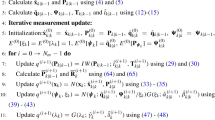Appendices
1.1 A. Proofs of (29)–(33)
Substituting \({\varvec{\theta }}={\hat{{\varvec{x}}}}_{k|k-1}\), \({\varvec{\theta }}={\varvec{r}}\) and (28) in (26), \(\log q^{(i+1)}({\hat{{\varvec{x}}}}_{k|k-1})\) and \(\log q^{(i+1)}({\varvec{r}})\) are written as
$$\begin{aligned}&\log q^{(i+1)}({\hat{{\varvec{x}}}}_{k|k-1})=-\frac{1}{2}\mathrm {E}^{(i)} \left[ \left( {\varvec{x}}_{k}-{\hat{{\varvec{x}}}}_{k|k-1}\right) ^{\mathrm {T}} {\varvec{P}}_{k|k-1}^{-1}\left( {\varvec{x}}_{k}-{\hat{{\varvec{x}}}}_{k|k-1}\right) \right] \nonumber \\&\quad -\,\frac{1}{2}\alpha _{k}\left( {\hat{{\varvec{x}}}}_{k|k-1}-{\varvec{u}}_{k}\right) ^{\mathrm {T}} \mathrm {E}^{(i)}\left[ {\varvec{P}}_{k|k-1}^{-1}\right] \left( {\hat{{\varvec{x}}}}_{k|k-1}-{\varvec{u}}_{k}\right) +c_{{\hat{{\varvec{x}}}}_{k|k-1}}, \end{aligned}$$
(81)
$$\begin{aligned}&\log q^{(i+1)}({\varvec{r}})=-\frac{1}{2}\mathrm {E}^{(i)}\left[ \left( {\varvec{z}}_{k} -{\varvec{H}}_{k}{\varvec{x}}_{k}-{\varvec{r}}\right) ^{\mathrm {T}}{\varvec{R}}^{-1} \left( {\varvec{z}}_{k}-{\varvec{H}}_{k}{\varvec{x}}_{k}-{\varvec{r}}\right) \right] \nonumber \\&\quad -\,\frac{1}{2}\beta _{k}\left( {\varvec{r}}-{\varvec{\lambda }}_{k}\right) ^{\mathrm {T}} \mathrm {E}^{(i)}\left[ {\varvec{R}}^{-1}\right] \left( {\varvec{r}}-{\varvec{\lambda }}_{k}\right) +c_{{\varvec{r}}}. \end{aligned}$$
(82)
The first expectations in (81)–(82) are calculated as follows
$$\begin{aligned}&\mathrm {E}^{(i)}\left[ \left( {\varvec{x}}_{k}-{\hat{{\varvec{x}}}}_{k|k-1} \right) ^{\mathrm {T}}{\varvec{P}}_{k|k-1}^{-1}\left( {\varvec{x}}_{k}-{\hat{{\varvec{x}}}}_{k|k-1} \right) \right] \nonumber \\&\quad =\mathrm {tr}\left\{ \mathrm {E}^{(i)}\left[ \left( {\varvec{x}}_{k}-{\hat{{\varvec{x}}}}_{k|k-1} \right) \left( {\varvec{x}}_{k}-{\hat{{\varvec{x}}}}_{k|k-1}\right) ^{\mathrm {T}}\right] \mathrm {E}^{(i)}\left[ {\varvec{P}}_{k|k-1}^{-1}\right] \right\} \nonumber \\&\quad =\mathrm {tr}\left\{ \mathrm {E}^{(i)}\left[ \left( {\varvec{x}}_{k}-{\hat{{\varvec{x}}}}_{k|k}^{(i)} +{\hat{{\varvec{x}}}}_{k|k}^{(i)}-{\hat{{\varvec{x}}}}_{k|k-1}\right) \left( {\varvec{x}}_{k} -{\hat{{\varvec{x}}}}_{k|k}^{(i)}+\right. \right. \right. \left. \left. \left. {\hat{{\varvec{x}}}}_{k|k}^{(i)}-{\hat{{\varvec{x}}}}_{k|k-1}\right) ^{\mathrm {T}}\right] \times \right. \nonumber \\&\left. \mathrm {E}^{(i)}\left[ {\varvec{P}}_{k|k-1}^{-1}\right] \right\} \nonumber \\&\quad =\left( {\hat{{\varvec{x}}}}_{k|k}^{(i)}-{\hat{{\varvec{x}}}}_{k|k-1}\right) ^{\mathrm {T}} \mathrm {E}^{(i)}\left[ {\varvec{P}}_{k|k-1}^{-1}\right] \left( {\hat{{\varvec{x}}}}_{k|k}^{(i)} -{\hat{{\varvec{x}}}}_{k|k-1}\right) +c_{{\hat{{\varvec{x}}}}_{k|k-1}}, \end{aligned}$$
(83)
$$\begin{aligned}&\mathrm {E}^{(i)}\left[ \left( {\varvec{z}}_{k}-{\varvec{H}}_{k}{\varvec{x}}_{k} -{\varvec{r}}\right) ^{\mathrm {T}}{\varvec{R}}^{-1}\left( {\varvec{z}}_{k}-{\varvec{H}}_{k} {\varvec{x}}_{k}-{\varvec{r}}\right) \right] \nonumber \\&\quad =\mathrm {tr}\{\left. \mathrm {E}^{(i)}\left[ \left( {\varvec{z}}_{k} -{\varvec{H}}_{k}{\varvec{x}}_{k}-{\varvec{r}}\right) \left( {\varvec{z}}_{k}-{\varvec{H}}_{k}{\varvec{x}}_{k} -{\varvec{r}}\right) ^{\mathrm {T}}\right] \mathrm {E}^{(i)}\left[ {\varvec{R}}^{-1}\right] \right\} \nonumber \\&\quad =\mathrm {tr}\{\mathrm {E}^{(i)}[({\varvec{z}}_{k}-{\varvec{H}}_{k} {\hat{{\varvec{x}}}}_{k|k}^{(i)}-{\varvec{r}}-{\varvec{H}}_{k}({\varvec{x}}_{k} -{\hat{{\varvec{x}}}}_{k|k}^{(i)}))({\varvec{z}}_{k}-{\varvec{H}}_{k}{\hat{{\varvec{x}}}}_{k|k}^{(i)} -{\varvec{r}}- \nonumber \\&{\varvec{H}}_{k}({\varvec{x}}_{k}-{\hat{{\varvec{x}}}}_{k|k}^{(i)}))^{\mathrm {T}}] \mathrm {E}^{(i)}\left[ {\varvec{R}}^{-1}\right] \} \nonumber \\&\quad =\left( {\varvec{z}}_{k}-{\varvec{H}}_{k}{\hat{{\varvec{x}}}}_{k|k}^{(i)}-{\varvec{r}} \right) ^{\mathrm {T}}\mathrm {E}^{(i)}\left[ {\varvec{R}}^{-1}\right] \left( {\varvec{z}}_{k}-{\varvec{H}}_{k}{\hat{{\varvec{x}}}}_{k|k}^{(i)}-{\varvec{r}}\right) +c_{{\varvec{r}}}. \end{aligned}$$
(84)
Substituting (83)–(84) in (81)–(82) and using (33) yields
$$\begin{aligned}&\log q^{(i+1)}({\hat{{\varvec{x}}}}_{k|k-1})=-\frac{1}{2} \left( {\hat{{\varvec{x}}}}_{k|k}^{(i)}-{\hat{{\varvec{x}}}}_{k|k-1}\right) ^{\mathrm {T}} \left[ {\varvec{\bar{P}}}_{k|k-1}^{(i)}\right] ^{-1}\left( {\hat{{\varvec{x}}}}_{k|k}^{(i)} -{\hat{{\varvec{x}}}}_{k|k-1}\right) \nonumber \\&\quad -\,\frac{1}{2}\alpha _{k}\left( {\hat{{\varvec{x}}}}_{k|k-1}-{\varvec{u}}_{k}\right) ^{\mathrm {T}} \left[ {\varvec{\bar{P}}}_{k|k-1}^{(i)}\right] ^{-1}\left( {\hat{{\varvec{x}}}}_{k|k-1}-{\varvec{u}}_{k} \right) +c_{{\hat{{\varvec{x}}}}_{k|k-1}}, \end{aligned}$$
(85)
$$\begin{aligned}&\log q^{(i+1)}({\varvec{r}})=-\frac{1}{2}\left( {\varvec{z}}_{k} -{\varvec{H}}_{k}{\hat{{\varvec{x}}}}_{k|k}^{(i)}-{\varvec{r}}\right) ^{\mathrm {T}} \left[ {\varvec{\bar{R}}}_{k}^{(i)}\right] ^{-1}\left( {\varvec{z}}_{k}-{\varvec{H}}_{k} {\hat{{\varvec{x}}}}_{k|k}^{(i)}-{\varvec{r}}\right) \nonumber \\&\quad -\,\frac{1}{2}\beta _{k}\left( {\varvec{r}}-{\varvec{\lambda }}_{k}\right) ^{\mathrm {T}} \left[ {\varvec{\bar{R}}}_{k}^{(i)}\right] ^{-1}\left( {\varvec{r}}-{\varvec{\lambda }}_{k}\right) +c_{{\varvec{r}}}. \end{aligned}$$
(86)
Utilizing (85)–(86), we can obtain (29)–(32).
1.2 B. Proofs of (34)–(43)
Exploiting \({\varvec{\theta }}={\varvec{P}}_{k|k-1}\), \({\varvec{\theta }}={\varvec{R}}\) and (28) in (26), \(\log q^{(i+1)}({\varvec{P}}_{k|k-1})\) and \(\log q^{(i+1)}({\varvec{R}})\) are calculated as
$$\begin{aligned}&\log q^{(i+1)}({\varvec{P}}_{k|k-1})=-\frac{1}{2}(\omega _{k}+n+3)\log \left| {\varvec{P}}_{k|k-1}\right| \nonumber \\&\quad -\,\frac{1}{2}\mathrm {E}^{(i)}\left[ \left( {\varvec{x}}_{k}-{\hat{{\varvec{x}}}}_{k|k-1} \right) ^{\mathrm {T}}{\varvec{P}}_{k|k-1}^{-1}\left( {\varvec{x}}_{k}-{\hat{{\varvec{x}}}}_{k|k-1} \right) \right] \nonumber \\&\quad -\,\frac{1}{2}\alpha _{k}\mathrm {E}^{(i)}\left[ \left( {\hat{{\varvec{x}}}}_{k|k-1} -{\varvec{u}}_{k}\right) ^{\mathrm {T}}{\varvec{P}}_{k|k-1}^{-1}({\hat{{\varvec{x}}}}_{k|k-1} -{\varvec{u}}_{k})\right] \nonumber \\&\quad -\,\frac{1}{2}\mathrm {tr}\left\{ {\varvec{\varSigma }}_{k}{\varvec{P}}_{k|k-1}^{-1}\right\} +c_{{\varvec{P}}_{k|k-1}}, \end{aligned}$$
(87)
$$\begin{aligned}&\log q^{(i+1)}({\varvec{R}})=-\frac{1}{2}(\nu _{k}+m+3)\log \left| {\varvec{R}}\right| \nonumber \\&\quad -\,\frac{1}{2}\mathrm {E}^{(i)}\left[ \left( {\varvec{z}}_{k}-{\varvec{H}}_{k}{\varvec{x}}_{k} -{\varvec{r}}\right) ^{\mathrm {T}}{\varvec{R}}^{-1}\left( {\varvec{z}}_{k}-{\varvec{H}}_{k}{\varvec{x}}_{k} -{\varvec{r}}\right) \right] \nonumber \\&\quad -\,\frac{1}{2}\beta _{k}\mathrm {E}^{(i)}\left[ \left( {\varvec{r}}-{\varvec{\lambda }}_{k} \right) ^{\mathrm {T}}{\varvec{R}}^{-1}\left( {\varvec{r}}-{\varvec{\lambda }}_{k}\right) \right] -\frac{1}{2}\mathrm {tr}\left\{ {\varvec{\varDelta }}_{k}{\varvec{R}}^{-1}\right\} +c_{{\varvec{R}}}. \end{aligned}$$
(88)
Substituting (40)–(43) in (87)–(88) gives
$$\begin{aligned} \log q^{(i+1)}({\varvec{P}}_{k|k-1})= & {} -\frac{1}{2}(\omega _{k}+n+3)\log \left| {\varvec{P}}_{k|k-1}\right| \nonumber \\&\quad -\,\frac{1}{2}\mathrm {tr}\left\{ \left( {\varvec{A}}_{k}^{(i+1)}+{\varvec{B}}_{k}^{(i+1)} +{\varvec{\varSigma }}_{k}\right) {\varvec{P}}_{k|k-1}^{-1}\right\} +c_{{\varvec{P}}_{k|k-1}},\qquad \end{aligned}$$
(89)
$$\begin{aligned} \log q^{(i+1)}({\varvec{R}})= & {} -\frac{1}{2}(\nu _{k}+m+3)\log \left| {\varvec{R}}\right| \nonumber \\&\quad -\,\frac{1}{2}\mathrm {tr}\left\{ \left( {\varvec{C}}_{k}^{(i+1)} +{\varvec{D}}_{k}^{(i+1)}+{\varvec{\varDelta }}_{k}\right) {\varvec{R}}^{-1}\right\} +c_{{\varvec{R}}}. \end{aligned}$$
(90)
According to (89)–(90), we can obtain (34)–(39).
1.3 C. Proofs of (44)–(47)
Using \({\varvec{\theta }}={\varvec{x}}_{k}\) and (28) in (26), \(\log q^{(i+1)}({\varvec{x}}_{k})\) can be formulated as
$$\begin{aligned} \log q^{(i+1)}({\varvec{x}}_{k})= & {} -\frac{1}{2}\mathrm {tr}\left\{ \mathrm {E}^{(i+1)} \left[ \left( {\varvec{z}}_{k}-{\varvec{H}}_{k}{\varvec{x}}_{k}-{\varvec{r}}\right) \times \right. \right. \left. \left. \left( {\varvec{z}}_{k}-{\varvec{H}}_{k}{\varvec{x}}_{k} -{\varvec{r}}\right) ^{\mathrm {T}}\right] \times \mathrm {E}^{(i+1)}\left[ {\varvec{R}}^{-1}\right] \right\} \nonumber \\&\quad -\,\frac{1}{2}\mathrm {tr}\left\{ \mathrm {E}^{(i+1)}\left[ \left( {\varvec{x}}_{k} -{\hat{{\varvec{x}}}}_{k|k-1}\right) \left( {\varvec{x}}_{k}-{\hat{{\varvec{x}}}}_{k|k-1} \right) ^{\mathrm {T}}\right] \right. \left. \mathrm {E}^{(i+1)} \left[ {\varvec{P}}_{k|k-1}^{-1}\right] \right\} +c_{{\varvec{x}}_{k}}, \nonumber \\ \end{aligned}$$
(91)
where the first and third expectations are calculated as
$$\begin{aligned}&\mathrm {E}^{(i+1)}\left[ \left( {\varvec{z}}_{k}-{\varvec{H}}_{k}{\varvec{x}}_{k} -{\varvec{r}}\right) \left( {\varvec{z}}_{k}-{\varvec{H}}_{k}{\varvec{x}}_{k} -{\varvec{r}}\right) ^{\mathrm {T}}\right] \nonumber \\&\quad =\,\mathrm {E}^{(i+1)} \left[ \left( {\varvec{z}}_{k}-{\varvec{H}}_{k}{\varvec{x}}_{k}-\right. \left. {\hat{{\varvec{\lambda }}}}_{k}^{(i+1)}+{\hat{{\varvec{\lambda }}}}_{k}^{(i+1)} -{\varvec{r}}\right) \left( {\varvec{z}}_{k}-{\varvec{H}}_{k}{\varvec{x}}_{k} -{\hat{{\varvec{\lambda }}}}_{k}^{(i+1)}+{\hat{{\varvec{\lambda }}}}_{k}^{(i+1)} -{\varvec{r}}\right) ^{\mathrm {T}}\right] \nonumber \\&\quad =\left( {\varvec{z}}_{k}-\right. \left. {\hat{{\varvec{\lambda }}}}_{k}^{(i+1)} -{\varvec{H}}_{k}{\varvec{x}}_{k}\right) \left( {\varvec{z}}_{k}-{\hat{{\varvec{\lambda }}}}_{k}^{(i+1)} -{\varvec{H}}_{k}{\varvec{x}}_{k}\right) ^{\mathrm {T}}+{\hat{{\varvec{\varOmega }}}}_{k}^{(i+1)}, \end{aligned}$$
(92)
$$\begin{aligned}&\mathrm {E}^{(i+1)}\left[ \left( {\varvec{x}}_{k}-{\hat{{\varvec{x}}}}_{k|k-1}\right) \left( {\varvec{x}}_{k}-{\hat{{\varvec{x}}}}_{k|k-1}\right) ^{\mathrm {T}}\right] \nonumber \\&\quad =\mathrm {E}^{(i+1)}\left[ \left( {\varvec{x}}_{k}-\right. \right. \left. \left. {\hat{{\varvec{u}}}}_{k}^{(i+1)}+{\hat{{\varvec{u}}}}_{k}^{(i+1)}-{\hat{{\varvec{x}}}}_{k|k-1}\right) \left( {\varvec{x}}_{k}-{\hat{{\varvec{u}}}}_{k}^{(i+1)}+{\hat{{\varvec{u}}}}_{k}^{(i+1)}-\right. \right. \left. \left. {\hat{{\varvec{x}}}}_{k|k-1}\right) ^{\mathrm {T}}\right] \nonumber \\&\quad =\left( {\varvec{x}}_{k}-{\hat{{\varvec{u}}}}_{k}^{(i+1)}\right) \left( {\varvec{x}}_{k} -{\hat{{\varvec{u}}}}_{k}^{(i+1)}\right) ^{\mathrm {T}}+{\hat{{\varvec{U}}}}_{k}^{(i+1)}. \end{aligned}$$
(93)
Employing (31) and (92)–(93) in (91) yields
$$\begin{aligned}&\log q^{(i+1)}({\varvec{x}}_{k})=-\frac{1}{2}\left( {\varvec{z}}_{k} -{\hat{{\varvec{\lambda }}}}_{k}^{(i+1)}-{\varvec{H}}_{k}{\varvec{x}}_{k}\right) ^{\mathrm {T}} \left[ {\varvec{\bar{R}}}_{k}^{(i)}\right] ^{-1}\left( {\varvec{z}}_{k} -{\hat{{\varvec{\lambda }}}}_{k}^{(i+1)}-{\varvec{H}}_{k}{\varvec{x}}_{k}\right) \nonumber \\&\quad -\,\frac{1}{2}\left( {\varvec{x}}_{k}-{\hat{{\varvec{u}}}}_{k}^{(i+1)}\right) ^{\mathrm {T}} \times \left[ {\varvec{\bar{P}}}_{k|k-1}^{(i)}\right] ^{-1}\left( {\varvec{x}}_{k} -{\hat{{\varvec{u}}}}_{k}^{(i+1)}\right) +c_{{\varvec{x}}_{k}}, \end{aligned}$$
(94)
According to (94), we can obtain (44)–(47), where (45)–(47) is given by the measurement update of the Kalman filter.
1.4 D. Proofs of (55)–(58)
Exploiting (29)–(30) and (44), the auxiliary parameters \({\varvec{A}}_{k}^{(i+1)}\), \({\varvec{B}}_{k}^{(i+1)}\), \({\varvec{C}}_{k}^{(i+1)}\) and \({\varvec{D}}_{k}^{(i+1)}\) in (40)–(43) can be, respectively, calculated as
$$\begin{aligned} {\varvec{A}}_{k}^{(i+1)}= & {} \mathrm {E}^{(i)}\left[ \left( {\varvec{x}}_{k} -{\hat{{\varvec{x}}}}_{k|k}^{(i)}+{\hat{{\varvec{x}}}}_{k|k}^{(i)}-{\hat{{\varvec{u}}}}_{k}^{(i+1)} +{\hat{{\varvec{u}}}}_{k}^{(i+1)}-\right. \right. \left. \left. {\hat{{\varvec{x}}}}_{k|k-1}\right) \left( {\varvec{x}}_{k}-{\hat{{\varvec{x}}}}_{k|k}^{(i)}\right. \right. \nonumber \\&\quad +\,\left. \left. {\hat{{\varvec{x}}}}_{k|k}^{(i)}-{\hat{{\varvec{u}}}}_{k}^{(i+1)} +{\hat{{\varvec{u}}}}_{k}^{(i+1)}-{\hat{{\varvec{x}}}}_{k|k-1}\right) ^{\mathrm {T}}\right] \nonumber \\= & {} {\varvec{P}}_{k|k}^{(i)}+\left( {\hat{{\varvec{x}}}}_{k|k}^{(i)}-{\hat{{\varvec{u}}}}_{k}^{(i+1)} \right) \left( {\hat{{\varvec{x}}}}_{k|k}^{(i)}-{\hat{{\varvec{u}}}}_{k}^{(i+1)}\right) ^{\mathrm {T}} +{\hat{{\varvec{U}}}}_{k}^{(i+1)}, \end{aligned}$$
(95)
$$\begin{aligned} {\varvec{B}}_{k}^{(i+1)}= & {} \alpha _{k}\mathrm {E}^{(i+1)} \left[ \left( {\hat{{\varvec{x}}}}_{k|k-1}-{\hat{{\varvec{u}}}}_{k}^{(i+1)}+{\hat{{\varvec{u}}}}_{k}^{(i+1)} -{\varvec{u}}_{k}\right) \right. \nonumber \\&\quad \times \left. \left( {\hat{{\varvec{x}}}}_{k|k-1}-{\hat{{\varvec{u}}}}_{k}^{(i+1)}+{\hat{{\varvec{u}}}}_{k}^{(i+1)} -{\varvec{u}}_{k}\right) ^{\mathrm {T}}\right] \nonumber \\= & {} \alpha _{k}{\hat{{\varvec{U}}}}_{k}^{(i+1)}+\alpha _{k}\left( {\hat{{\varvec{u}}}}_{k}^{(i+1)} -{\varvec{u}}_{k}\right) \left( {\hat{{\varvec{u}}}}_{k}^{(i+1)}-{\varvec{u}}_{k}\right) ^{\mathrm {T}}, \end{aligned}$$
(96)
$$\begin{aligned} {\varvec{C}}_{k}^{(i+1)}= & {} \mathrm {E}^{(i)}\left[ \left( {\varvec{z}}_{k}-{\varvec{H}}_{k} {\hat{{\varvec{x}}}}_{k|k}^{(i)}-{\hat{{\varvec{\lambda }}}}_{k}^{(i+1)}-{\varvec{H}}_{k}({\varvec{x}}_{k} -{\hat{{\varvec{x}}}}_{k|k}^{(i)})+{\hat{{\varvec{\lambda }}}}_{k}^{(i+1)}-{\varvec{r}}\right) \right. \nonumber \\&\quad \times \left( {\varvec{z}}_{k}-{\varvec{H}}_{k}{\hat{{\varvec{x}}}}_{k|k}^{(i)}-{\hat{{\varvec{\lambda }}}}_{k}^{(i+1)} -{\varvec{H}}_{k}({\varvec{x}}_{k}-{\hat{{\varvec{x}}}}_{k|k}^{(i)})\right. \left. \left. +{\hat{{\varvec{\lambda }}}}_{k}^{(i+1)}-{\varvec{r}}\right) ^{\mathrm {T}}\right] \nonumber \\= & {} {\varvec{H}}_{k}{\varvec{P}}_{k|k}^{(i)}{\varvec{H}}_{k}^{\mathrm {T}}+{\hat{{\varvec{\varOmega }}}}_{k}^{(i+1)} +\left( {\varvec{z}}_{k}-{\varvec{H}}_{k}{\hat{{\varvec{x}}}}_{k|k}^{(i)}-{\hat{{\varvec{\lambda }}}}_{k}^{(i+1)} \right) \left( {\varvec{z}}_{k}-{\varvec{H}}_{k}{\hat{{\varvec{x}}}}_{k|k}^{(i)}- {\hat{{\varvec{\lambda }}}}_{k}^{(i+1)}\right) ^{\mathrm {T}}, \end{aligned}$$
(97)
$$\begin{aligned} {\varvec{D}}_{k}^{(i+1)}= & {} \beta _{k}\mathrm {E}^{(i+1)}\left[ \left( {\varvec{r}} -{\hat{{\varvec{\lambda }}}}_{k}^{(i+1)}+{\hat{{\varvec{\lambda }}}}_{k}^{(i+1)} -{\varvec{\lambda }}_{k}\right) \right. \left. \left( {\varvec{r}}-{\hat{{\varvec{\lambda }}}}_{k}^{(i+1)} +{\hat{{\varvec{\lambda }}}}_{k}^{(i+1)}-{\varvec{\lambda }}_{k}\right) ^{\mathrm {T}}\right] \nonumber \\= & {} \beta _{k}{\hat{{\varvec{\varOmega }}}}_{k}^{(i+1)}+\beta _{k} \left( {\hat{{\varvec{\lambda }}}}_{k}^{(i+1)}-{\varvec{\lambda }}_{k}\right) \left( {\hat{{\varvec{\lambda }}}}_{k}^{(i+1)}-{\varvec{\lambda }}_{k}\right) ^{\mathrm {T}}. \end{aligned}$$
(98)
According to (95)–(98), we can obtain (55)–(58).















